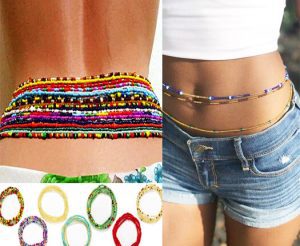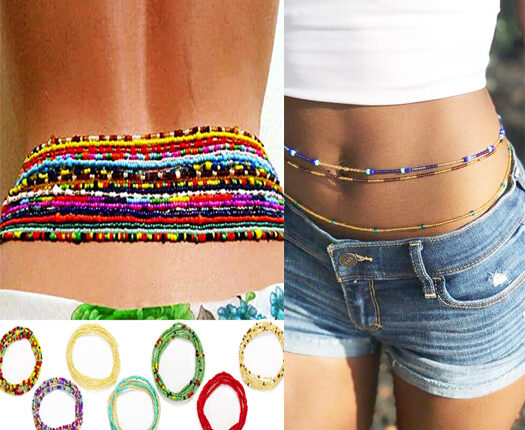Waist beads seem to have a special appeal to both the onlooker and the wearer. These traditional ornaments have been in use by Africans, including Nigerian women, for ages. The variety of colors, and the way they flow and crackle with waist movements is somewhat enchanting.


Even more curious is the discovery that lots of modern women (both young and old) still prefer to wear waist beads. So what’s really special about waist beads, one may ask? Let’s explore the ancestry of waist beads in a moment, before concluding on why they are still sought after by modern women.
Also Read- 10 Popular Nigerian Superstitions You Should Know
Where do Waist Beads Come From?
Waist beads are basically beads – small ornaments made out of glass, stones, crystals, cowries, wood – and more recently – plastic and metal. These beads are arranged on a string and worn around the waist. Waist beads are called different names across the West African region depending on the tribe. Some tribal names include Jigida, Mgbaji, Ileke Idi (or Bebedi), Giri-Giri, Jel-Jelli, Perles, Bin Bin, Djalay and Yomba.
Some waist beads are not adjustable – they would need to be changed as the wearer outgrows them in girth. While some modern ones are elastic or extensible, so they can adjust to an increased (or reduced) belly or waist size. Waist beads come in a wide array of colors, sizes and patterns.
Waist beads are believed to have originated from Egypt, and were referred to as ‘girdles’. But how they were imported into West Africa is not clear. However, they have become a beauty accessory of huge cultural and health importance in West Africa and beyond.
Reports have it that sometime between the 16th and 18th Centuries, Arab and Portuguese traders introduced waist beads into East Africa. In southern Africa, Zambian and Malawi women are said to wear them particularly during pregnancy, or to entice their spouses. Thus the use of waist beads has now become a widely accepted African lifestyle.
And would it surprise you to know that women outside Africa – in Asia and Europe for instance, also wear waist beads? However, some men see them as diabolical, and not without reason (as we shall soon see).
Importance of Waist Beads to Women: Nigeria and Beyond
Beauty
The wearer may choose to hide them under clothes or expose them; but in any case, waist beads can be colorful. It makes the wearer look more attractive and lively.
Self Esteem
Should a woman feel insecure about her body shape, wearing waist beads may increase her self-esteem. The beauty and appeal of these beads can sharply improve her appearance. It can also make the wearer more confident of herself.
Sign of Maturity & Fertility
In the traditional setting, mothers adorn their daughters with waist beads to show they have ‘come of age’. It can mark the age of adolescence, or fertility, when a young woman has become old enough to become a mother. The Ashante and Krobo people of Ghana would add bells and large beads to their daughters’ waist beads. So that as they move, they can ‘make noise’ and attract potential suitors – a way of announcing their readiness to give birth.
For Weight Control
Wearing waist beads of the sort that is not adjustable, is an easy way to check your weight. As the wearer gains weight, the beads tighten and slide higher up the waist. But they drop lower when she loses weight. That way, she can monitor how she gains and loses body fat.
Erotic/Sensual Appeal
For married women (or women with sexual partners), wearing waist beads can arouse sexual desire in their men. The appealing colors, movements, and sounds of these beads can make the wearer appear seductive. And they may even increase sexual satisfaction during intercourse.
To Control Posture (or body shaping)
The use of waist beads tends to draw more attention to one’s body – especially your posture and stomach. When a woman sits, stands, and walks around with waist beads, they fit differently in each case. The wearer is forced to adjust her posture and sit up straight for improved breathing, or a trimmer stomach. Thus, she learns to control and relax her stomach muscles as is necessary. These actions can indirectly improve body shape.
Culture and Heritage
Women across Africa and in the diaspora see the wearing of waist beads as a means of connecting to their African roots. It is a reminder of where they came from, and they take pride in their ancestry.
Spiritual/Magical Uses
The Yoruba, Ghanaian, and some other West African tribes traditionally lace their waist beads with cowries, fragrant oils and/or charms. By doing so, they further entice possible suitors; and perhaps it will serve as an aphrodisiac. These charms may also be used as spiritual protection from predators or attackers.
However, the downside of using charms comes when its potency wanes. That is, when the partner discovers he is being manipulated with black magic and walks away. Or – the charm works negatively to invite a predator, violating its original intent. But on the brighter side, adding crystals or special stones could invoke healing, general wellness, or positive energy to the benefit of the wearer.
Wearing Waist Beads: Any Side Effects?
- Some of these beads may cause discomfort and allergic reactions on the wearer’s skin. They may even lead to injuries if broken.
- Possible infections may occur, if the waist beads are not cleaned or changed in a long time.
- The belief in spiritual protection or inducing love by wearing charmed waist beads may sadly disappoint the wearer. The partner may abandon or maltreat such a woman along the line, especially if he finds out the truth.
- Tagging a wearer of waist beads as a loose or diabolic woman is quite common.
The Significance of Colors in Waist Beads
Colors mean different things to different people. And depending on the culture or tribe it is associated with, the colors of waist beads also convey special meanings. Each color may be associated with one aspect of physical or mental well-being, or a desired virtue. The colors below are generally associated with the virtues that follow each of them.
- Yellow (wisdom, clarity, awareness, energy, joy)
- Blue (loyalty, healing, harmony, insight, truth)
- Brown (earth, stability)
- White (light, purity, truth)
- Purple (spirituality, wisdom, royalty)
- Red (passion, bravery, vitality, confidence)
- Green (abundance, fertility, prosperity, healing, hope)
- Gold (power, wealth, good health)
- Black (Power, protection)
- Orange(self-confidence, vitality, courage)
- Pink (love, beauty, kindness, care)








